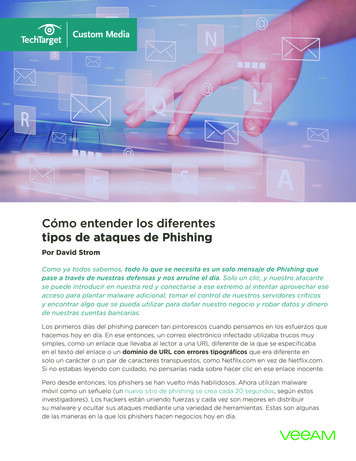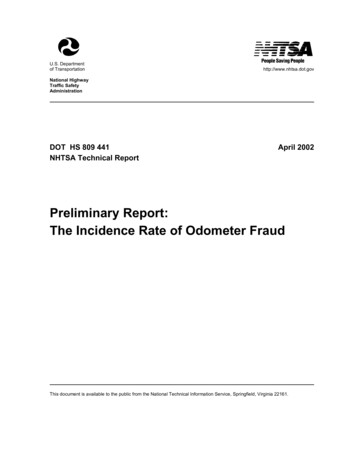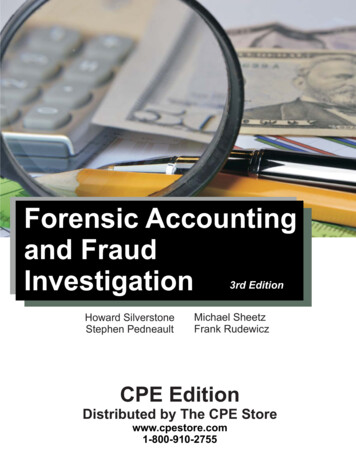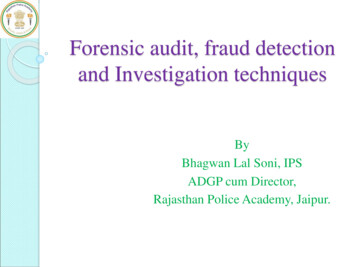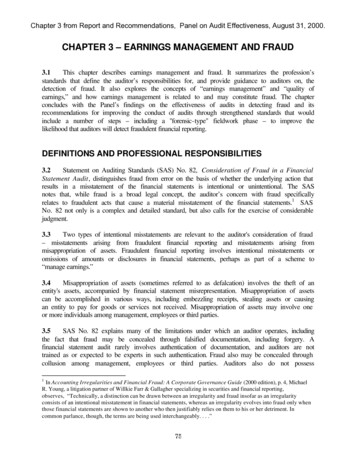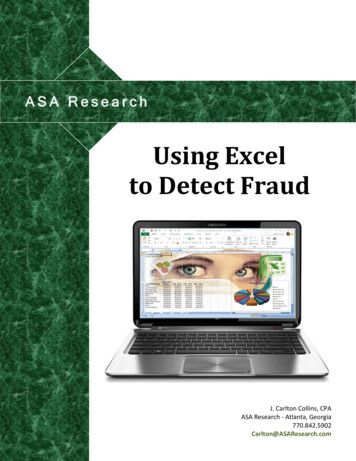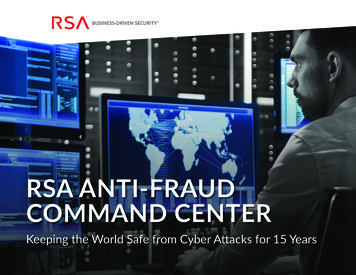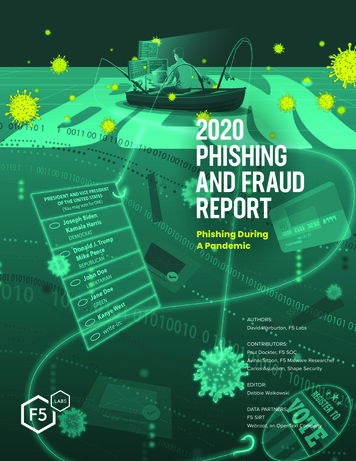
Transcription
2020PHISHINGAND FRAUDREPORTPhishing DuringA PandemicAUTHORS:David Warburton, F5 LabsCONTRIBUTORS:Paul Dockter, F5 SOCAvihai Sitbon, F5 Malware ResearcherCarlos Asuncion, Shape SecurityEDITOR:Debbie WalkowskiDATA PARTNERS:F5 SIRTWebroot, an OpenText Company2020 PHISHING AND FRAUD REPORT1
Table of ContentsExecutive Summary 2Introduction 4Steps in a Phishing Attack 10The Business of Phishing 11Modern Phishing Practices 18The Future of Phishing 32Combating Phishing 36Conclusion 39Our Methods 40Glossary 41Endnotes 432020 PHISHING AND FRAUD REPORT1
Executive SummaryPhishing remains a popular method of stealing credentials, committing fraud, and distributingmalware. But what appears on the surface to be a juvenile form of cybercrime can be, in practice,a well-orchestrated, multi-faceted, and sustained attack campaign by organized crime groups.From finding victims and creating phishing sites, to harvesting and fraudulently using victims’credentials, it can be difficult to build a complete picture of the end-to-end process. We focus ourreport on how fraudsters are building and hosting their phishing sites, and the tactics they use toremain hidden. Using insight from Shape Security, we also show how quickly cybercriminals aremaking use of their stolen goods.WE FOCUS OUR REPORT ON HOW FRAUDSTERS ARE BUILDINGAND HOSTING THEIR PHISHING SITES, AND THE TACTICS THEYUSE TO REMAIN HIDDENThis year’s Phishing and Fraud report examines five years’ worth of phishing incidents fromthe F5 Security Operations Center (SOC), deep dives into active and confirmed phishing sitessupplied by OpenText’s Webroot BrightCloud Threat Intelligence, and analyzes darkweb marketdata from Vigilante. Together, these help build a comprehensive and consistent pictureof the world of phishing.In our 2019 Phishing and Fraud Report, we noted a significant abuse of free and automatedservices, such as blogging platforms and free digital certificate services. Fraudsters made heavyuse of automation with very little, if any, financial outlay. We saw emerging use of encryption withjust over half of all sites leveraging HTTPS, and attackers were creating lengthy and deceptiveweb addresses (URLs) in order to appear genuine and confuse their victims.2020 PHISHING AND FRAUD REPORT2
The past twelve months has been not a revolution in the attackers’ methods but an evolution,15%INCREASE IN PHISHINGINCIDENTS IN 2020and 2020 is on target to see a 15% increase in phishing incidents compared with last year. Thisyear we found that phishing incidents rose by a staggering 220% compared to the yearly averageduring the height of global pandemic fears. Fraudsters were quick to seize upon the confusionand we saw large spikes in phishing activities that closely coincide with various lockdown rulesand the increase in homeworking. Using certificate transparency logs, we found that at its peak,there were almost 15,000 active certificates using “covid” or “coronavirus” in their names. Onthe topic of encryption, the use of HTTPS also rose sharply across all phishing sites with animpressive 72% making use of digital certificates and TLS encryption. The dramatic increase inphishing activity at the beginning of lockdown could well be a factor in the sharp rise of stolenpayment cards discovered in May and June of this year. The number of cards of seven majorglobal banks found on darknet markets was almost double a similar peak period in 2019.WE FOUND THAT PHISHING INCIDENTS ROSE BY A STAGGERING 220% COMPARED TO THE YEARLY AVERAGE DURING THEHEIGHT OF GLOBAL PANDEMICFraudsters are becoming more creative with the names and locations of their phishing sites.Attempting to create ever more realistic website addresses, we found that 55% of phishing sitesmade use of target brand names and identities in their URLs. We tracked theft of credentialsthrough to their use in active attacks and found that criminals were attempting to use them withinfour hours. In some cases, the attacks occurred in real time.Vulnerable websites continue to present an opportunity for fraudsters to host their phishingpages on a reputable URL, for free. We found that WordPress sites alone accounted for 20%of generic phishing URLs.This year we also found that Office 365 continues to present a rich and compelling target forattackers with fraudsters employing new tactics such as “consent phishing”. And an increasingnumber of phishing sites are using evasion techniques to avoid detection and inspection bytargeted businesses and security researchers.Despite the continued growth of phishing attacks, security controls and user training are failing toadequately combat it. Fraudsters know that the way to make a quick buck isn’t to spend monthsattempting to breach an organizations security, it’s simply to ask nicely for the username andpassword so they can walk right in through the front door.2020 PHISHING AND FRAUD REPORT3
IntroductionPhishing, the email focused form of social engineering, shows no sign of abating. It remainsjust as popular with organized cybercrime as it is with nation states for one simple reason: itworks. The number of phishing incidents in 2020 is projected to increase by 15% comparedwith last year, according to data from the F5 Security Operations Center (SOC) (see Figure 1).F5 Labs’ 2020 Application Protection Report found that 52% of all breaches in the US weredue to failures at the access control layer. These include credential theft, brute force loginattempts, and phishing. Across the pond, data released by the UK’s Information Commissioner’sOffice (ICO), showed that phishing was the number one cause of cyber related data breachfor their reporting period covering April 2019 to March 2020, accounting for 28% of all cases.iThe trend continues all over the world. Numbers from the Office of the Australian InformationCommissioner (OAIC) show that phishing holds the top spot in malicious cyber incidents,accounting for 36% of all cases reported to them.ii Theft of credentials, one of the most commoninitial attack vectors for cybercriminals, is a close second and is responsible for 29% of allincidents (July 2019 to June 2020).FIGURE 1. PHISHING INCIDENTS DEALT WITH BY F5’sSECURITY OPERATIONS CENTERTo protect customer confidentiality, we do not mention specific organizations ordivulge numbers. We instead compare increase levels in incident reports.2015201620172018201920202020 PHISHING AND FRAUD REPORT4
Phishing is now such a problem that the 2020 Verizon Data Breach Investigations Report(DBIR) noted the use of malware and trojans had dropped significantly and that “attackersbecome increasingly efficient and lean more toward attacks such as phishing and credentialtheft.”iii Europol’s latest Internet Organised Crime Threat Assessment (IOCTA) report stated,“Social engineering and phishing remain a key threat,” and that “both demonstrate a significantincrease in volume and sophistication.”iv Yet, while the organized cybercriminal element areindeed becoming far more skilled in their use of social engineering, using multi-vector attacksand intercepting SMS tokens, phishing has dramatically increased due to the ease with which itcan be conducted. Phishing kits and Phishing-as-a-Service, not to mention the ease with whichpersonal data can be obtained, all mean that virtually anyone can start a phishing campaign withvery little prior knowledge. Since likelihood is a factor in calculating risk, we must assume that ourrisk of being phished is now greater than ever.PHISHING HAS DRAMATICALLY INCREASED DUE TO THEEASE WITH WHICH IT CAN BE CONDUCTEDNon-cash payment fraud, such as credit card theft, skimming, or phishing, is commonly usedto enable the majority of other cyber-dependent crime, such as extortion, theft of data, anddeployment of malware. Advanced persistent threat (APT) groups have long been known toconduct active cyber espionage campaigns. Social engineering of APTs’ victims via email andsocial media phishing campaigns is commonly the first step in the attack chain. In September2020, a new campaign by the Iranian-linked Charming Kitten APT combined targeted spearphishing via WhatsApp with bogus LinkedIn profiles in order to create believable back stories.Their aim was to trick the victim into downloading malware or harvest the victim’s credentials.vSOCIAL ENGINEERING OF APTs’ VICTIMS VIA EMAIL ANDSOCIAL MEDIA PHISHING CAMPAIGNS IS COMMONLY THEFIRST STEP IN THE ATTACK CHAINBusiness email compromise (BEC)—spear-phishing that targets staff members who have accessand the authority to transfer money—is on the rise as attackers show an increased understandingof internal business relationships and processes. The second-quarter 2020 report from the AntiPhishing Working Group (APWG) showed that the average wire transfer attempt was more than 80,000, with one specific threat actor targeting companies for an average of 1.27 million.viDespite many advanced tools, techniques, and procedures (TTPs), many phishing attacks aresimple in nature and succeed because of poor security controls and lack of awareness by users.2020 PHISHING AND FRAUD REPORT5
How Cybercriminals Capitalized onCOVID-19 in 2020Always keen to hook onto emotive topics, cybercriminals were quick to capitalize on the globaloutbreak of SARS-CoV-2, colloquially known as Coronavirus or COVID-19. While millions of people struggled to learn the real facts about the pandemic from world leaders, the morally absentcybercriminal community saw their opportunity. Phishing emails began hitting inboxes aroundmid-March with subject lines such as “Covid-19 in your area?” and “Message from the WorldHealth Organization.”Phishing Subject Line Examples Covid-19 in your area? Please confirm your address Click here for COVID-19 vaccinations Get your COVID-19 CARES Act relief check here Counterfeit Respirators, sanitizers, PPE Fake cures for COVID-19 Message from the World Health Organization Message from the Centers for Disease Control and Prevention Click here for Coronavirus-related information Donate to these charitable organizations. Message from Local hospital— Need patient data for COVID-19 testing COVID 19 Preparation Guidance 2019-nCoV: Coronavirus outbreak in your city (Emergency) HIGH-RISK: New confirmed cases in your city Coronavirus (2019-nCoV) Safety Measures2020 PHISHING AND FRAUD REPORT6
The APWG reported that targets were predominantly “workers, healthcare facilities and therecently unemployed.”vii Figures 2 and 3 show just two samples of many pandemic-relatedphishing emails F5 Labs has seen.Three primary objectives for COVID-19 related phishing emails became apparent. Fraudstersfocused their efforts on: Asking for donations to fake charities Credential harvesting Malware deliveryWhile criminals seized on the opportunity to spoof login and download pages for increasinglypopular web conferencing apps, such as Zoom, Skype, and WebEx, it’s remarkable howunremarkable many of these attacks really were. Europol’s IOCTA 2020 report summarizes thiswell stating, “COVID-19 demonstrated how cybercrime—at its core—remains largely the same butcriminals change the narrative.”viii This echoes the previous discovery by F5 Labs of a Mirai botnetlazily cloned to include references to COVID-19.FIGURE 2. A PHISHING EMAIL THAT USED FEAR OF THEPANDEMIC TO HOOK ITS VICTIMSFIGURE 3. A COVID-19 RELATED PHISHING EMAIL WITH AMALICIOUS POWERPOINT PRESENTATION ATTACHED2020 PHISHING AND FRAUD REPORT7
The number of phishing incidents reported to the UK ICO for each quarter of 2019 and 2020averaged 289, while new figures, released for the months covering April to June 2020, show asharp decline with only 185 confirmed cases. The F5 Security Operations Center (SOC) saw asimilar trend, with initial phishing statistics broadly following patterns of previous years but witha large spike around the start of 2020, a slump between March and April, and another significantrise over the spring and early summer months (see Figure 4).Across the SOC datasets for the months of July to September, we found 320 unique maliciousdomains making use of the specific terms “covid” or “corona” in their URLs. Many other malicioussites used deliberate misspellings or simply used unrelated domain names for their attacks.Using certificate transparency logs, we can also search for specific words or values within HTTPScertificates. It is no surprise that when the pandemic was headlining every news outlet in March,the number of certificates created that month with the words “covid” or “corona” peaked at14,940 (see Figure 5).Security practitioners are generally well aware of how phishers bait and hook their victims byusing provocative topics, but if these trends tell us anything, it’s that end users—our staff and ourcustomers—need to know this. Phishing awareness training must drive home the message thatattackers are quick to jump onto new trends. Users need to be extra vigilant watching for email,voicemails, and text messages that appear to be related to widely discussed topics in the mediaor popular culture.PHISHING AWARENESS TRAINING MUST DRIVE HOMETHE MESSAGE THAT ATTACKERS ARE QUICK TO JUMPONTO NEW TRENDS2020 PHISHING AND FRAUD REPORT8
FIGURE 4. PHISHING INCIDENTS DEALT WITH BY F5 SOCFIGURE 4. PHISHING INCIDENTS DEALT WITH BY F5 SOCJANFEBMARAPRMAYJUN2015-2019JULAUGSEPOCTNOVJUN ‘20JUL ‘20AUG ‘20DEC2020FIGURE 5. RATE OF NEW CERTIFICATES CONTAINING THEFIGURE“COVID”5. RATE OROF CENSYS.IO “COVID” OR “CORONA.”DATA OBTAINED FROM CENSYS.IO1600014000120001000080006000400020000NOV ‘19DEC ‘19JAN ‘20FEB ‘20MAR ‘20APR ‘20MAY ‘20SEP ‘202020 PHISHING AND FRAUD REPORT9
STEPS IN A PHISHING ATTACKSELECT VICTIMSDELIVER PHISHINGHOOKCull frompast breachesImpersonatingEmailBYPASS FILTERSUse attachments notcommonly blocked(Doc, Zip, pdf)EXECUTIONSMS MessageMix legit graphicsand links in messagewith false onesPurchase ListsHijack legit siteor social/ emailmedia account andphish followersVictim goes tomalicious websiteVoice MailCredentials, creditcards, accountsall sold on darketmarketsMalware executesand pivots internally(Ransomware)Malware createspersistentconnection tocorporate networkdata exfilMalicious websitecollects credentialsCashing outcredit cardsMalicious websitecollects paymentcard data andpersonal infoMalware collectsadditional personaldetailsMalicious websitelaunches drive-bydownloadMalware turnsdevice into a botfor cryptomining orother attacksUse URL Shortenerto hide true addressScrape from web/Social mediaLeverage orsubvert legit pentest or admin toolsPAY OUTMalware executesand collectscredentialsVictim clicks onexecutable andruns malwareGuess based onorganization andemail structureSocial Media/Web CommentEXPLOITATION2020 PHISHING AND FRAUD REPORT10
The Business of PhishingThere are many ways to phish, and the tools and tactics required are often determined by whatthe attacker is aiming to catch. As we covered in F5 Labs’ 2019 Phishing and Fraud Report, thethree broad methods of phishing are: General, indiscriminate, in which the attacker targets many unrelated victims knowingthat they are likely to get a few bites Semi-targeted, in which attacks are focused against a specific organization or group Spear phishing, in which a specific individual (often C-level or IT administrator) isdirectly targeted.While the catch (the pay-out) might be different between phishing campaigns (some attackers arelooking to harvest credentials while others want to distribute malware), the commonality is thatfraudsters use one or more social engineering tactics to circumvent a victim’s critical thinking.In a 2013 paper, A Study of Social Engineering in Online Frauds, the authors found the fivemost common methods of persuasion used were authority, urgency, fear/threat, politeness, andformality.ix In 100% of those cases, the cybercriminal used authority, and 71% of phishing emailsadded a sense of urgency. Whether it be a missed package delivery, a deadline for a competition,or threat of imminent “legal action,” fraudsters know that persuading us to rush increases thelikelihood that we will not logically evaluate the request. This year we’ve very much seen thisto hold true with the huge jump in phishing traffic around the periods of national pandemiclockdowns and many examples of emails claiming to have information about the virus.Phishing ObjectivesSocial engineering, and primarily phishing, is often used as an enabler of both newer cyberdependent crime (for example, ransomware and website compromise) as well as cyber-enabledcrime (such as fraud and theft). Here, we focus on two of the most common abjectives forfraudsters: credential harvesting and financial fraud.2020 PHISHING AND FRAUD REPORT11
FIGURE 6. COUNT OF DATA BREACH INCIDENTS PER YEAR OVERLAYINGTHE NUMBER OF CUMULATIVE DATA RECORDS BREACHED(displaying only incidents with known number of records breached)BREACHESRUNNING TOTAL40353025201510502004 2005 2006 2007 2008 2009 2010 2011 2012 2013 2014 2015 2016 2017 2018 2019 20200200040006000800010000120001400016000180002020 PHISHING AND FRAUD REPORT12
Credential HarvestingUsernames, email addresses, and passwords can often be the actual target of the fraudster,with stolen credentials commonly selling in bulk on darknet markets. These data sets of stolencredentials are purchased by other organized crime groups to enable others to carry out activitiessuch as credential stuffing attacks.More often, however, credentials are used to accomplish further objectives such as the theft ofintellectual property or committing financial fraud. Attackers rarely have a problem obtainingusable credentials. Shape Security’s 2018 Credential Spill Report found that 2.3 billion credentialswere breached in 2017.x And 2017 was, according to Wikipedia, a quiet year for data breaches.xiFigure 6 shows the number of data breach incidents per year compared with the cumulativenumber of records breached. Despite a fluctuating number of incidents from year to year, thetotal number of records lost or stolen appears to be growing almost exponentially.Office 365 Provides a Rich TargetMicrosoft’s incredibly popular email, productivity, and collaboration platform, Office 365, is aprime target for attackers. Once credentials have been captured, attackers have a multitude ofoptions open to them. They might choose to send more fraudulent emails, now with the benefitof having them appear to come from a genuine corporate account. This same Office 365 accountis likely to have access to SharePoint and OneDrive, which could provide direct access tointellectual property and sensitive data. The worst-case scenario might involve the compromisedaccount being a member of a privileged access group, which then gives the attacker the ability tomodify access privileges for the Office 365 platform itself.A common tactic to phish for Office 365 credentials is to send a victim an email claiming that aWord or Excel document has been shared with them. To retrieve it, the victim must authenticateto the (spoofed) Office 365 website.2020 PHISHING AND FRAUD REPORT13
Consent PhishingNow that businesses are starting to better secure their credentials (by federating user accounts,performing device posture checks, and applying MFA), fraudsters are beginning to shift theirtargets. With credentials becoming harder to steal, fraudsters are asking the victim for directaccess to their account in an attack called consent phishing.There are hundreds of mobile and desktops apps that promise to tidy your inbox, organize yourcontacts, or provide some incredibly useful new productivity feature. To use these apps, all youhave to do is download it to your phone or laptop and authorize it to connect to your Gmail orOffice 365 account.The process for authorizing apps to your email or productivity platform is as follows:1.Tell your new app of choice what platform you use, for example, Office 3652.Your app then directs y
supplied by OpenText’s Webroot BrightCloud Threat Intelligence, and analyzes darkweb market data from Vigilante. Together, these help build a comprehensive and consistent picture of the world of phishing. In our 2019 Phishing and Fraud R
